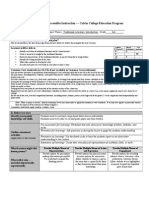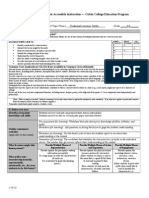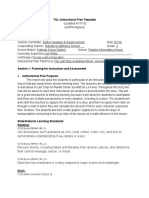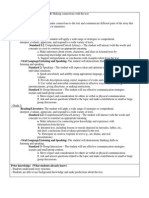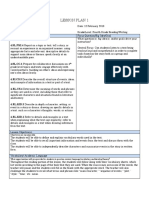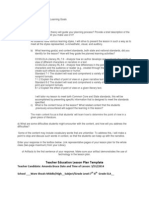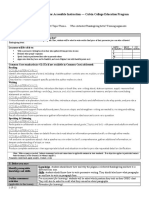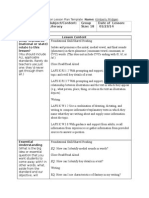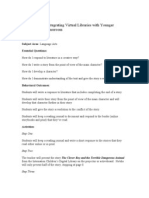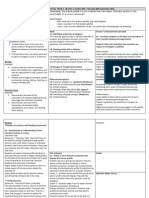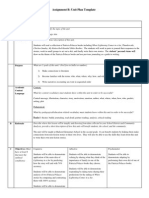Final Lesson
Final Lesson
Uploaded by
api-300649730Copyright:
Available Formats
Final Lesson
Final Lesson
Uploaded by
api-300649730Original Title
Copyright
Available Formats
Share this document
Did you find this document useful?
Is this content inappropriate?
Copyright:
Available Formats
Final Lesson
Final Lesson
Uploaded by
api-300649730Copyright:
Available Formats
Lesson Planning Form for Accessible Instruction Calvin College Education Program
Teacher Mikaela Deur
Date
11/02/15
Subject/ Topic/ Theme
Traditional Literature: Review
Grade _____3rd_______
I. Objectives
How does this lesson connect to the unit plan?
This lesson recaps all of the forms of messages from the past that we have touched on. The students have the chance to use what theyve learned to create their own
traditional literature.
cognitiveR U Ap An E C*
Learners will be able to:
Identify each form of traditional literature and its characteristics.
Create a lesson to be taught by the traditional literature.
Point out characteristics of the traditional literature in specific form that is being written.
Identify the setting and plot of the story
Work with a partner to develop the story
Describe how parts of a text build on each other to make a story
R
E
An
R
E
U
physical
development
socioemotional
P
RP
P
Common Core standards (or GLCEs if not available in Common Core) addressed:
Ask and answer questions to demonstrate understanding of a text, referring explicitly to the text as the basis for the answers. (R.CM.0302)
Recount stories, including fables, folktales, and myths from diverse cultures; determine the central message, lesson, or moral and explain how it is conveyed through
details in the text.
Describe characters in a story (e.g., their traits, motivations, or feelings) and explain how their actions contribute to the sequence of events. (R.NET.03.03)
Determine the meaning of words and phrases as they are used in a text, distinguishing literal from non-literal language. (R.CM.03.03)
Refer to parts of stories, dramas, and poems when writing or speaking about a text, using terms such as chapter, scene, and stanza; describe how each successive part
builds on earlier sections.
Distinguish their own point of view from that of the narrator or those of the characters.
Explain how specific aspects of a texts illustrations contribute to what is conveyed by the words in a story (e.g., create mood, emphasize aspects of a character or
setting).
By the end of the year, read and comprehend literature, including stories, dramas, poetry, at the high end of the grades 2-3 text complexity band independently and
proficiently.
(Note: Write as many as needed. Indicate taxonomy levels and connections to applicable national or state standards. If an objective applies to particular learners
write the name(s) of the learner(s) to whom it applies.)
*remember, understand, apply, analyze, evaluate, create
II. Before you start
Identify prerequisite
knowledge and skills.
Outline assessment
activities
(applicable to this lesson)
What barriers might this
lesson present?
What will it take
neurodevelopmentally,
experientially,
1-19-13
Students need to read and comprehend short stories individually.
Students need to be able to cut and paste paper into their folders.
Pre-assessment (for learning): Worksheet that asks about prior knowledge of fables, folktales, and
myths.
Formative (for learning): Ask questions as during the lesson to gage the students understanding.
Formative (as learning): Use the thumb scale to have the students report to me about their
understanding or the content
Summative (of learning): Create their own physical representation of a folktale, fable, or myth.
Provide Multiple Means of
Representation
Provide options for perceptionmaking information perceptible
Use large pre-written posters with
the characteristics of fables, myths,
and folktales.
Use worksheets to guide the
thinking process.
Provide Multiple Means of Action
and Expression
Provide options for physical actionincrease options for interaction
Allow students to choose a spot in
the room that is a good fit for them
as they brainstorm about and write
their story.
Provide Multiple Means of
Engagement
Provide options for recruiting
interest- choice, relevance, value,
authenticity, minimize threats
Allow students to pick what they
would like their piece of traditional
literature to be about and how to
represent it.
Provide options for language,
mathematical expressions, and
symbols- clarify & connect
language
Have students list the
characteristics they want to
have in their own story, then
represent it in their own way
Provide options for comprehensionactivate, apply & highlight
emotionally, etc., for your
students to do this lesson?
Materials-what materials
(books, handouts, etc) do
you need for this lesson
and are they ready to
use?
How will your classroom
be set up for this lesson?
Have students use what they
learned in full group discussion
time to identify the
characteristics themselves.
Provide options for expression and
communication- increase medium
of expression
Students use their own words to
write a piece of literature of
their choosing.
They have the chance to come
up with a creative way to show
their story.
Provide options for sustaining effort
and persistence- optimize
challenge, collaboration, masteryoriented feedback
Give positive feedback for well
done work.
Provide options for executive
functions- coordinate short & long
term goals, monitor progress, and
modify strategies
Provide options for self-regulationexpectations, personal skills and
strategies, self-assessment &
reflection
Use the short term goals of
knowledge of individual
traditional literature forms to
create their own piece of
traditional literature.
Have the students use folders to
remain organized and have
visual representation of the
content being covered.
Use a thumb scale for
understanding. If a student feels
like they understand the
concepts being taught, they give
a thumbs up, if they dont they
give a thumbs down, and if they
kind of understand it their
thumb is in the middle. This is a
way for the students to practice
self-assessment.
iPads
Chromebooks
Paper
Staples
Coloring supplies
Premade posters with characteristics of fables, folktales, and myths on them.
The classroom will remain in the same set up. Desks are in clusters.
The students will start in the back of the room in the reading rectangle and then move to a self
determined spot that is best fit for their success.
III. The Plan
Time
Components
Motivation
(opening/
introduction/
engagement)
Development
(the largest
component or
main body of
the lesson)
Describe teacher activities
AND
student activities
for each component of the lesson. Include important higher order thinking questions and/or
prompts.
Begin by going over the forms of traditional
Reflect on knowledge from previous lessons and
literature with the students. Ask them to identify
identify the characteristics
folktales, fables, and myths based on what we
learned in previous lessons.
Inform the students that they now get the chance to
create their own folktale, myth, or fable.
Have them begin by choosing a folktale, a myth, or
a fable.
Give options to students about how to create their
story: They can use Scribble my Story on iPads,
Google slides, paper and colored pencils
Have the students use the worksheets to identify
how the characteristics of a fable, a folktale, or a
myth will be used in their story.
1-19-13
Choose a folktale, fable, or myth
Release students to work groups of 2 or three on
creating their story.
Identify the characteristics that need to be added to
the story
Choose how to create the story.
Work with partner to create story
Closure
(conclusion,
culmination,
wrap-up)
Have students return to their seats.
Share story with the class.
Have them share what they created with the class,
identifying the characteristics of their form of
traditional literature.
Your reflection about the lesson, including evidence(s) of student learning and engagement, as well as ideas for improvement
for next time. (Write this after teaching the lesson, if you had a chance to teach it. If you did not teach this lesson, focus on the
process of preparing the lesson.)
1-19-13
You might also like
- English Unit - NanberryDocument12 pagesEnglish Unit - Nanberryapi-237136245100% (6)
- PYP Unit Planner G1 Who We Are 2014Document4 pagesPYP Unit Planner G1 Who We Are 2014Shelby Nail88% (8)
- J.S. Bach's Clavier Figured Bass InstructionsDocument10 pagesJ.S. Bach's Clavier Figured Bass InstructionsDWCason100% (15)
- Engl 9 - The Garden Party Lesson Plan PT 2Document4 pagesEngl 9 - The Garden Party Lesson Plan PT 2api-292290183No ratings yet
- Early Narratives and The Epic of Gilgamesh Unit PlanDocument18 pagesEarly Narratives and The Epic of Gilgamesh Unit Planapi-299930429No ratings yet
- Speaking and Listening Lesson PlanDocument4 pagesSpeaking and Listening Lesson Planapi-296333288No ratings yet
- Lesson Plan 20minDocument3 pagesLesson Plan 20minapi-294890109100% (1)
- Carl RogersDocument21 pagesCarl RogersEdz SoretsellaBNo ratings yet
- RWS 11.1.2 (Selecting and Organizing Info)Document3 pagesRWS 11.1.2 (Selecting and Organizing Info)QuenieMarielIlar100% (10)
- First LessonDocument3 pagesFirst Lessonapi-300649730No ratings yet
- Myths LessonDocument3 pagesMyths Lessonapi-300649730No ratings yet
- Unit Plan Lesson FolktalesDocument3 pagesUnit Plan Lesson Folktalesapi-300649730No ratings yet
- Lesson Plan Day 6Document4 pagesLesson Plan Day 6api-317730714No ratings yet
- Lesson 7 Outsiders CH 5Document14 pagesLesson 7 Outsiders CH 5api-349579702No ratings yet
- Lesson Number FiveDocument3 pagesLesson Number Fiveapi-284181679No ratings yet
- Lesson 6Document2 pagesLesson 6api-273233127No ratings yet
- Unit Plan Lesson 5Document3 pagesUnit Plan Lesson 5api-337406556100% (1)
- Social Justice Lesson PlanDocument9 pagesSocial Justice Lesson Planapi-350131256No ratings yet
- Read Write and Talk Lesson Plan-Adapted For ToolkitDocument3 pagesRead Write and Talk Lesson Plan-Adapted For Toolkitapi-272654945No ratings yet
- Year 11 English Pwys Creative Writing UnitDocument21 pagesYear 11 English Pwys Creative Writing Unitapi-264766686100% (1)
- Unit Plan Non FictioneditedDocument8 pagesUnit Plan Non Fictioneditedapi-311702790No ratings yet
- TMS Ass10Document9 pagesTMS Ass10madonselafrance6No ratings yet
- Singzon Opinion Writing Learning SegmentDocument12 pagesSingzon Opinion Writing Learning Segmentapi-742234328No ratings yet
- Edu 542 Lesson 1Document6 pagesEdu 542 Lesson 1api-347962298No ratings yet
- Lesson 7Document2 pagesLesson 7api-273233127No ratings yet
- About This Lesson: DescriptionDocument8 pagesAbout This Lesson: Descriptionapi-272099906No ratings yet
- Lesson 5Document3 pagesLesson 5api-302454223No ratings yet
- Grade 2 Explicit Instruction Personal Narrative Writing UnitDocument42 pagesGrade 2 Explicit Instruction Personal Narrative Writing UnitRoopaliSharma100% (2)
- Iteachaz Lesson Plan Template (Direct Instruction)Document3 pagesIteachaz Lesson Plan Template (Direct Instruction)api-302315328No ratings yet
- Text StructDocument43 pagesText StructDinno JorgeNo ratings yet
- Childrens Lit Unit and Lesson PlansDocument18 pagesChildrens Lit Unit and Lesson Plansapi-384819868No ratings yet
- Final Exam Lesson Plan 4 1Document8 pagesFinal Exam Lesson Plan 4 1api-302766620No ratings yet
- Literacy Lesson Plan and Commentary Assignment 1Document13 pagesLiteracy Lesson Plan and Commentary Assignment 1api-744273648No ratings yet
- Millicent Atkins School of Education: Common Lesson Plan TemplateDocument34 pagesMillicent Atkins School of Education: Common Lesson Plan Templateapi-383013037No ratings yet
- Task 3-Backwards DesignDocument11 pagesTask 3-Backwards Designapi-335318523No ratings yet
- Pioneer LessonDocument8 pagesPioneer Lessonapi-340407741No ratings yet
- Ppat Section 3Document8 pagesPpat Section 3api-237235020No ratings yet
- Eds 332 Lesson 2Document10 pagesEds 332 Lesson 2api-297788513No ratings yet
- Lesson Planning Form For Accessible Instruction - Calvin College Education ProgramDocument4 pagesLesson Planning Form For Accessible Instruction - Calvin College Education Programapi-339549780No ratings yet
- Day 3Document3 pagesDay 3api-284853302No ratings yet
- Guided NarrativeDocument4 pagesGuided Narrativeapi-296514525No ratings yet
- First Lesson For ObservationDocument5 pagesFirst Lesson For Observationapi-311362989No ratings yet
- Mini Lesson Plan EDU 536Document3 pagesMini Lesson Plan EDU 536api-347962298No ratings yet
- Lessonplanusftemplate 123Document9 pagesLessonplanusftemplate 123api-242740031No ratings yet
- Character and Theme Using Values Com BillboardsDocument2 pagesCharacter and Theme Using Values Com Billboardsapi-232796980No ratings yet
- Teaching Literacy in The Elementary Grades Through LiteratureDocument5 pagesTeaching Literacy in The Elementary Grades Through LiteratureSunshine ArceoNo ratings yet
- Early Childhood Program Lesson Plan Format Junior SpringDocument12 pagesEarly Childhood Program Lesson Plan Format Junior Springapi-508716116No ratings yet
- Eled 440 - Reading and Writing Lesson PlanDocument3 pagesEled 440 - Reading and Writing Lesson Planapi-314242191No ratings yet
- Book in A Bag Lesson PlanDocument3 pagesBook in A Bag Lesson Planapi-509266258No ratings yet
- Edla - Comprehension UnitDocument6 pagesEdla - Comprehension Unitapi-452856462No ratings yet
- 7461 Lesson Plan For Integrating Virtual Libraries With Younger Students in The Classroom JerDocument5 pages7461 Lesson Plan For Integrating Virtual Libraries With Younger Students in The Classroom Jerapi-203008463No ratings yet
- SIOP Lesson Plan - Neighborhood OdesDocument4 pagesSIOP Lesson Plan - Neighborhood OdescindisolNo ratings yet
- Blease Task1 LPDocument20 pagesBlease Task1 LPapi-265863941No ratings yet
- LessonplanassignmentDocument8 pagesLessonplanassignmentapi-324050926No ratings yet
- Early Childhood Program Lesson Plan Format Junior Spring: Whole Class: Heterogeneous MixDocument14 pagesEarly Childhood Program Lesson Plan Format Junior Spring: Whole Class: Heterogeneous Mixapi-509778700No ratings yet
- Interactive Read Aloud Lesson 2Document8 pagesInteractive Read Aloud Lesson 2api-399873247No ratings yet
- Lines of InquiryDocument3 pagesLines of InquiryteacherensNo ratings yet
- Pappas Unit Plan Fall 2013Document10 pagesPappas Unit Plan Fall 2013api-248985409No ratings yet
- WritinglessonDocument5 pagesWritinglessonapi-253646290No ratings yet
- Digital Unit Plan TemplateDocument4 pagesDigital Unit Plan Templateapi-239241893No ratings yet
- Edu 155 Social Studies LessonDocument23 pagesEdu 155 Social Studies Lessonapi-405028012No ratings yet
- TrumplessonplanDocument2 pagesTrumplessonplanapi-295695627No ratings yet
- Lesson 4Document4 pagesLesson 4api-245823147No ratings yet
- Thematic ApproachDocument13 pagesThematic ApproachVarun A Raman100% (2)
- Mary Hazel C. Beniga Rosemarie B. Bahan: Teacher's Comments/RemarksDocument2 pagesMary Hazel C. Beniga Rosemarie B. Bahan: Teacher's Comments/Remarksmary graceNo ratings yet
- RationaleDocument4 pagesRationaleSiti Nur FatinNo ratings yet
- MEJIA Ippd Form 20182019Document1 pageMEJIA Ippd Form 20182019Melody Mejia100% (6)
- District 1 Candidate Martha Barrett QuestionnaireDocument14 pagesDistrict 1 Candidate Martha Barrett QuestionnaireJacksonville Public Education FundNo ratings yet
- English AccomplishmentDocument4 pagesEnglish AccomplishmentjessNo ratings yet
- Clil FinlandDocument27 pagesClil Finlandcikgu juniorNo ratings yet
- Prepare Training ResourcesDocument6 pagesPrepare Training ResourcesjonellambayanNo ratings yet
- Suc NF 2012 Form-E2 InstructionsDocument27 pagesSuc NF 2012 Form-E2 InstructionsJeremiah Jude AbarcaNo ratings yet
- Reyna L. Pisaño: Summary of QualificationsDocument2 pagesReyna L. Pisaño: Summary of QualificationsReyna PisanoNo ratings yet
- Directory 2012 Naga City Division Private SchoolsDocument3 pagesDirectory 2012 Naga City Division Private SchoolsDeped Naga100% (1)
- Sec5group1 LessonplanDocument7 pagesSec5group1 Lessonplanapi-406106344No ratings yet
- Narrative report-GAD MAY 2019Document4 pagesNarrative report-GAD MAY 2019jein_amNo ratings yet
- Chapter 8 GraphsDocument58 pagesChapter 8 GraphsJojobaby51714No ratings yet
- Detailed Lesson Plan - SarahDocument6 pagesDetailed Lesson Plan - SarahSarah Jane Reyes100% (1)
- Alabama Department of Education Position Comparison With SalariesDocument1 pageAlabama Department of Education Position Comparison With SalariesTrisha Powell CrainNo ratings yet
- Introduction To: Seizing The Whip B. K. S. Iyengar and The Making of Modern Yoga, by Eric ShawDocument12 pagesIntroduction To: Seizing The Whip B. K. S. Iyengar and The Making of Modern Yoga, by Eric ShawEric ShawNo ratings yet
- LL.B. - HonsDocument11 pagesLL.B. - HonsMd Harun Ar RashidNo ratings yet
- Lesson Plan StoryDocument2 pagesLesson Plan Storyapi-307403882100% (1)
- Lesson Plan 1Document7 pagesLesson Plan 1api-381180592No ratings yet
- Ks3 Mathematics 2005 Level 6 8 Paper 1Document28 pagesKs3 Mathematics 2005 Level 6 8 Paper 1Dan SoundararajahNo ratings yet
- RPP Inviting SomeoneDocument3 pagesRPP Inviting SomeoneDimas EspressoloNo ratings yet
- Paper New Student Orientation Programs 4 15 14 FinalDocument13 pagesPaper New Student Orientation Programs 4 15 14 Finalapi-252324590No ratings yet
- Universal Basic Education in Nigeria: Matters ArisingDocument5 pagesUniversal Basic Education in Nigeria: Matters ArisingwalesHill100% (1)
- Algebra Success in 20 Minutes A DayDocument224 pagesAlgebra Success in 20 Minutes A Daygingerbd69100% (1)
- LESSON PLAN Micro TeachingDocument10 pagesLESSON PLAN Micro TeachingDinar Esa Dwi WahyuniNo ratings yet









